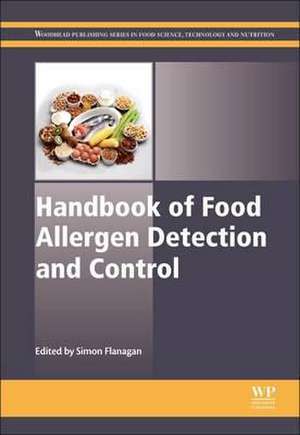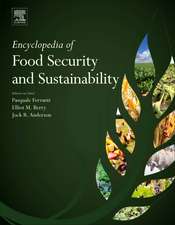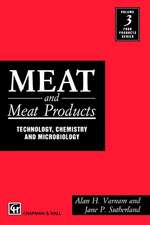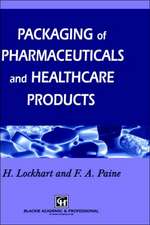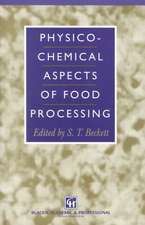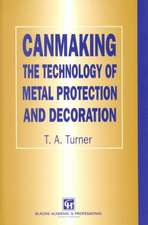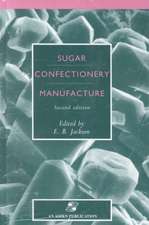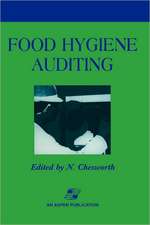Handbook of Food Allergen Detection and Control: Woodhead Publishing Series in Food Science, Technology and Nutrition
Editat de Simon Flanaganen Limba Engleză Hardback – 8 sep 2014
- Reviews current and emerging technologies for detecting and reducing allergens, as well as issues such as traceability, regulation and consumer attitudes
- Covers allergen management throughout the food chain and reviews current and emerging methods of allergen detection
- Examines methods for reducing and eliminating allergens in food and provides a detailed overview of the control and detection of individual food allergens
Din seria Woodhead Publishing Series in Food Science, Technology and Nutrition
- 15%
 Preț: 391.19 lei
Preț: 391.19 lei - 24%
 Preț: 1210.03 lei
Preț: 1210.03 lei - 24%
 Preț: 946.43 lei
Preț: 946.43 lei - 24%
 Preț: 960.56 lei
Preț: 960.56 lei - 23%
 Preț: 1419.50 lei
Preț: 1419.50 lei - 9%
 Preț: 1205.99 lei
Preț: 1205.99 lei - 24%
 Preț: 1189.10 lei
Preț: 1189.10 lei - 9%
 Preț: 1006.66 lei
Preț: 1006.66 lei - 9%
 Preț: 984.09 lei
Preț: 984.09 lei - 9%
 Preț: 1206.85 lei
Preț: 1206.85 lei - 24%
 Preț: 1081.43 lei
Preț: 1081.43 lei - 24%
 Preț: 1185.22 lei
Preț: 1185.22 lei - 9%
 Preț: 922.07 lei
Preț: 922.07 lei - 24%
 Preț: 1192.22 lei
Preț: 1192.22 lei - 9%
 Preț: 1215.75 lei
Preț: 1215.75 lei - 24%
 Preț: 1162.37 lei
Preț: 1162.37 lei - 9%
 Preț: 950.09 lei
Preț: 950.09 lei - 24%
 Preț: 1162.62 lei
Preț: 1162.62 lei - 24%
 Preț: 801.31 lei
Preț: 801.31 lei - 27%
 Preț: 379.84 lei
Preț: 379.84 lei - 29%
 Preț: 1336.07 lei
Preț: 1336.07 lei - 24%
 Preț: 798.74 lei
Preț: 798.74 lei - 9%
 Preț: 1018.93 lei
Preț: 1018.93 lei - 31%
 Preț: 922.77 lei
Preț: 922.77 lei - 9%
 Preț: 1045.58 lei
Preț: 1045.58 lei - 24%
 Preț: 1131.77 lei
Preț: 1131.77 lei - 23%
 Preț: 1635.83 lei
Preț: 1635.83 lei - 9%
 Preț: 1277.62 lei
Preț: 1277.62 lei - 24%
 Preț: 1049.04 lei
Preț: 1049.04 lei - 24%
 Preț: 1134.60 lei
Preț: 1134.60 lei - 9%
 Preț: 1076.36 lei
Preț: 1076.36 lei - 24%
 Preț: 1158.21 lei
Preț: 1158.21 lei - 9%
 Preț: 1065.06 lei
Preț: 1065.06 lei - 9%
 Preț: 1067.39 lei
Preț: 1067.39 lei - 24%
 Preț: 812.03 lei
Preț: 812.03 lei - 9%
 Preț: 1203.13 lei
Preț: 1203.13 lei - 23%
 Preț: 1237.19 lei
Preț: 1237.19 lei - 24%
 Preț: 948.79 lei
Preț: 948.79 lei - 23%
 Preț: 1138.06 lei
Preț: 1138.06 lei - 9%
 Preț: 868.43 lei
Preț: 868.43 lei - 24%
 Preț: 871.98 lei
Preț: 871.98 lei - 20%
 Preț: 1272.59 lei
Preț: 1272.59 lei - 29%
 Preț: 1195.06 lei
Preț: 1195.06 lei - 9%
 Preț: 1002.45 lei
Preț: 1002.45 lei - 9%
 Preț: 505.72 lei
Preț: 505.72 lei - 9%
 Preț: 1062.13 lei
Preț: 1062.13 lei - 24%
 Preț: 1306.94 lei
Preț: 1306.94 lei
Preț: 1333.02 lei
Preț vechi: 1748.10 lei
-24% Nou
Puncte Express: 2000
Preț estimativ în valută:
255.11€ • 263.54$ • 212.31£
255.11€ • 263.54$ • 212.31£
Carte tipărită la comandă
Livrare economică 19 martie-02 aprilie
Preluare comenzi: 021 569.72.76
Specificații
ISBN-13: 9781782420125
ISBN-10: 1782420126
Pagini: 448
Dimensiuni: 152 x 229 x 32 mm
Greutate: 0.79 kg
Editura: ELSEVIER SCIENCE
Seria Woodhead Publishing Series in Food Science, Technology and Nutrition
ISBN-10: 1782420126
Pagini: 448
Dimensiuni: 152 x 229 x 32 mm
Greutate: 0.79 kg
Editura: ELSEVIER SCIENCE
Seria Woodhead Publishing Series in Food Science, Technology and Nutrition
Cuprins
- List of contributors
- Woodhead Publishing Series in Food Science, Technology and Nutrition
- 1: Introduction to food allergy
- Abstract
- 1.1 Introduction: what is food allergy?
- 1.2 Other food intolerances
- 1.3 Food allergy prevalence and patterns
- 1.4 What is a food allergen?
- 1.5 Food allergen risk management
- 1.6 The value of having food allergen data
- 1.7 Challenges and considerations in food allergen analysis
- 1.8 Conclusions
- Part One: Managing allergens in the food chain
- 2: Traceability of allergenic foods in the food chain
- Abstract
- 2.1 Introduction
- 2.2 Legislation, standards and guidance
- 2.3 Traceability systems
- 2.4 Analytical methods used in traceability investigations
- 2.5 Conclusions
- 3: Food allergen risk assessment and management
- Abstract
- 3.1 Introduction
- 3.2 Food allergy as a public health issue
- 3.3 Risk assessment for food allergens: background and issues
- 3.4 Development of risk assessment for food allergens
- 3.5 Practical aspects of risk assessment
- 3.6 Risk management
- 3.7 Conclusions
- 4: Assessment and communication of allergen risks in the food chain
- Abstract
- 4.1 Introduction
- 4.2 Principles and methods
- 4.3 Allergen risk assessment and hazard characterisation
- 4.4 Risk communication
- 4.5 Risk assessment to allergen control plan
- 4.6 Current research and future trends
- 4.7 Conclusions
- 5: Hygienic design and cleaning as an allergen control measure
- Abstract
- 5.1 Introduction
- 5.2 Hygienic design: regulations and norms
- 5.3 Hygienic equipment design
- 5.4 Hygienic building design
- 5.5 Integrating hygienic systems/hygienic engineering
- 5.6 Cleaning as an allergen control measure
- 5.7 Allergen cleaning: verification and validation
- 6: Effective allergen management practices to reduce allergens in food
- Abstract
- 6.1 Introduction
- 6.2 The retailer’s perspective
- 6.3 The allergy journey
- 6.4 Labelling and packaging
- 6.5 Marks & Spencer packaging evolution
- 6.6 Allergen management risk assessment
- 6.7 Marks & Spencer’s risk assessment process
- 6.8 Factory standards and controls
- 6.9 Gluten-free
- 6.10 Next steps
- Acknowledgements
- 7: Consumer attitudes to allergens in foods
- Abstract
- 7.1 Introduction
- 7.2 Which consumers are avoiding foods and why?
- 7.3 What information do these consumers need?
- 7.4 Living with food allergy
- 7.5 Information from packaging
- 7.6 Challenges for consumers at different stages of life
- 7.7 Summary of consumer needs
- 7.8 How can food suppliers ensure consumer confidence and trust?
- 7.9 Conclusions and future trends
- 7.10 Sources of further information and advice
- Acknowledgements
- 8: Assessing and managing allergenicity of genetically modified (GM) foods
- Abstract
- 8.1 Introduction
- 8.2 Assessing the allergenicity of novel proteins
- 8.3 Key steps in allergenicity assessment
- 8.4 Environmental factors affecting allergenicity
- 8.5 Assessing the allergenicity of whole GM plants
- 8.6 Assessing the allergenicity of products from GM animals
- 8.7 Post-market monitoring
- 8.8 Conclusion
- 2: Traceability of allergenic foods in the food chain
- Part Two: Detecting allergens in food
- 9: Sampling for food allergens
- Abstract
- 9.1 Introduction
- 9.2 Reasons to sample for food allergens and sampling plans
- 9.3 Approaches to sampling
- 9.4 Sample types
- 9.5 Quality of the sample
- 9.6 Future trends
- 10: Enzyme-linked immunosorbent assays (ELISAs) for detecting allergens in food
- Abstract
- 10.1 Introduction
- 10.2 Principles of an enzyme immunoassay
- 10.3 Main components of ELISA
- 10.4 Detection issues relating to particular allergens: egg, milk, nuts, prolamins and glutelins
- 10.5 Validation, characteristical parameters of ELISA and collaborative studies
- 10.6 Conclusions
- 11: Lateral flow devices for detecting allergens in food
- Abstract
- 11.1 Introduction
- 11.2 Lateral flow devices
- 11.3 Development of a lateral flow device
- 11.4 Key issues in using lateral flow devices
- 11.5 Future trends
- 11.6 Conclusions
- 11.7 Sources of further information and advice
- 12: Surface plasmon resonance (SPR) sensors for detecting allergens in food
- Abstract
- 12.1 Introduction
- 12.2 Development of an SPR food allergen biosensor
- 12.3 Applications of SPR for food allergen detection: peanuts
- 12.4 Detection of shellfish toxins with SPR
- 12.5 High-throughput food allergen profiling with imaging SPR
- 12.6 Future trends
- 12.7 Conclusions
- 13: Polymerase chain reaction (PCR) methods for detecting allergens in foods
- Abstract
- 13.1 Introduction
- 13.2 Advantages of PCR for allergen detection
- 13.3 PCR principles and methods
- 13.4 Multi-allergen detection and quantification with PCR
- 13.5 PCR performance characteristics
- 13.6 Conclusions and future trends
- 14: Optical thin film biochips for detecting allergens in food
- Abstract
- 14.1 Introduction
- 14.2 Principles of optical thin film biochips
- 14.3 Applications for detection of allergenic foods
- 14.4 Advantages and disadvantages of optical thin film biosensor chip assays
- 14.5 Future trends
- 14.6 Conclusions
- 15: IgE antibody-based analysis for detecting allergens in food
- Abstract
- 15.1 Introduction
- 15.2 General considerations
- 15.3 IgE antibody-based in vivo assay for food allergen potency assessment
- 15.4 IgE antibody-based in vitro assays for food allergen potency assessment
- 15.5 Applications in the detection of peanuts
- 15.6 Allergosorbent competitive inhibition assay: strengths and weaknesses
- 15.7 Future trends
- Appendix: abbreviations
- 16: Validation, standardisation and harmonisation of analytical methods and test kits for detecting allergens in food
- Abstract
- 16.1 Introduction
- 16.2 Different methods for the detection of allergens in food
- 16.3 Comparing the different methods
- 16.4 Limitations of the different methods and how they can be overcome
- 16.5 Importance of validation and good practices
- 16.6 Challenges of standardisation and harmonisation of analytical methods
- 16.7 Future trends
- 9: Sampling for food allergens
- Part Three: Case studies: detection and control of specific food allergens
- 17: Detection and control of eggs as a food allergen
- Abstract
- 17.1 Introduction
- 17.2 Egg allergy
- 17.3 Egg allergens
- 17.4 Detection of egg allergens
- 17.5 Enzyme-linked immunosorbent assay (ELISA)
- 17.6 Other techniques: western blots, lateral flow and polymerase chain reaction (PCR) devices
- 17.7 Future trends
- 17.8 Conclusion
- 18: Detection and control of soybeans as a food allergen
- Abstract
- 18.1 Introduction
- 18.2 Soybeans and their food uses
- 18.3 Soybean allergy: prevalence and potency
- 18.4 Clinical manifestations and severity of soybean allergy
- 18.5 Soybean allergens
- 18.6 Detection of soy residues
- 18.7 Control of soy residues in food manufacturing facilities
- 18.8 Future trends
- 18.9 Conclusions
- 18.10 Sources of further information and advice
- 19: Detection and control of gluten as a food allergen
- Abstract
- 19.1 Introduction
- 19.2 Pathogenesis of celiac disease (CD)
- 19.3 Testing of gluten toxicity
- 19.4 Current EU labeling and codex guidelines
- 19.5 Methods for measurement of gluten contamination in foods
- 19.6 Future trends and summary
- 20: Detection and control of fish, shellfish and molluscs as food allergens
- Abstract
- 20.1 Introduction
- 20.2 Classification of seafood and seafood protein characteristics
- 20.3 Seafood as allergens
- 20.4 Epidemiology of seafood allergy
- 20.5 Manifestations of seafood allergies
- 20.6 Management of seafood allergies
- 20.7 Summary and future trends
- 21: Detection and control of mustard and sesame as food allergens
- Abstract
- 21.1 Introduction
- 21.2 Mustard as an allergen
- 21.3 The major allergic proteins in mustard
- 21.4 Detection of mustard allergens and markers in food
- 21.5 Sesame as an allergen
- 21.6 The major allergic proteins in sesame
- 21.7 Detection of sesame allergens and markers in food
- 21.8 Future trends
- 17: Detection and control of eggs as a food allergen
- Index
